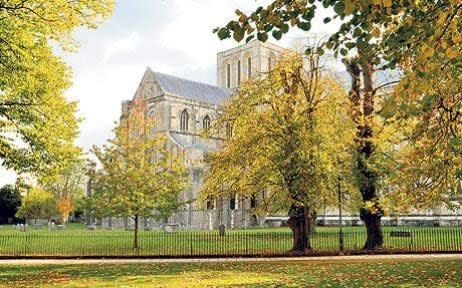St Swithin's Day: How a Saxon bishop's ire supposedly led to 40 days of rain – and what it could tell us about this year's summer

The idea of relentless rain for more than a month is an exhausting one – and even more disheartening over summer.
But according to folklore there's a chance we may have to withstand constant poor weather for a month and a half, dampening our hopes of a hot British summer both metaphorically and literally.
According to tradition, whatever the weather is like on St Swithin's Day – whether rainy or sunny – it will continue for the next 40 days and 40 nights.
But where does the legend come from, what does today's weather mean for the rest of summer – and (most importantly) is there any truth to it?
When is St Swithin's Day?
St Swithin's Day falls on July 15 every year.
Last year the day was predicted to be a cloudy, breezy day across the bulk of the UK, but with sunny, warm spells in the south and a lot of rain in the north. The prophecy implied an inconsistent summer, which is precisely what we got.
The Met Office summarised the summer's weather as wet yet warm, stating: "This summer was rather wet, with rainfall above average for the UK in each individual month.
"It was also slightly warmer than average but that is largely due to a warm June, as from mid-July onwards the weather was often on the cool side with an unsettled westerly regime."
While it was the equal fifth warmest June in a row since 1910, numerous areas exceeded twice their average rainfall, particularly in southern and eastern Scotland.
Who was St Swithin?
St Swithin (or St Swithun) was an Anglo-Saxon bishop at Winchester Cathedral who died in 862. At that time Winchester was the capital of the kingdom of Wessex.
He is believed to have been a trusted counsellor of Egbert, King of the West Saxons, and educated his son Ethelwulf who appointed him bishop.

Very little is known about his life and there's hardly any mention of him in documents from the time that he lived. However he was famed for his charity and church building and was made patron saint of Winchester Cathedral about 100 years after his death.
He supposedly performed just one miracle during his lifetime - making an old lady's eggs whole again after workmen smashed them while building a church.
Swithin is derived from the Old English word for "strong" and St Swithin's symbols are raindrops and apples.
Where did the legend originate?
As he lay on his deathbed St Swithin asked to be buried outside the Old Minster in Winchester, in a lowly grave where his body would be trodden and rained on.
However more than a century later, on July 15 971, Winchester monks moved his remains to an elaborate shrine inside the cathedral where pilgrims flocked, believing his bones to have miraculous healing properties.
But legend has it that St Swithin wasn't happy about his body being moved. On the day of the removal, ferocious and violent rain storms arrived lasting 40 days and nights which apparently represented his displeasure.

This story soon became folklore and now British people keep an eye on the weather on July 15. The superstition is expressed in the well-known rhyme.
St Swithin’s Day, if it does rain
Full forty days, it will remain
St Swithin’s Day, if it be fair
For forty days, t’will rain no more
Nothing remains of St Swithin's shrine which was destroyed during King Henry VIII's Reformation, but there's a memorial to him at Winchester Cathedral.
Other western European countries observe a similar day, dedicated to different saints.
In France, people keep watch for rain on July 19 (St Gervais' Day) and Germany's Seven Sleepers day (July 7) refers to the weather patterns over the next seven weeks.

What will the weather be like this year?
It bodes well for a hot and sunny summer: the Met Office has predicted that today will be a dry, fine and very warm day in England. The south-east will be hot, with the country enjoying long spells of sunshine with only a little patchy cloud.
While Scotland and Northern Ireland will see some cloud, with potential for a slow-moving band of rain, it will be mostly light and patchy.
We have already enjoyed record-breaking temperatures and weeks of sun over the past few months. Last month was the hottest June on record for Northern Ireland and Wales, and the fourth for Scotland and England based on 24-hour mean temperatures, the Met Office said.
The average maximum daytime temperature of 19.9C places it joint-second with June 1976 and just behind the 20.6C of June 1940, according to provisional figures.
With a sunny St Swithin's Day this year, it could mean the heatwave continues all the way through to the end of August.
Great! Is there any truth in it?
Not really. The Met Office says there has not been a record of 40 dry or 40 wet days following St Swithin's Day since records began in 1861.
However, according to the Royal Meteorological Society there is a tiny grain of truth to it. The weather in the UK often sets into a pattern around now, which only begins to change from the end of August as autumn nears.
It states on its website: "The middle of July tends to be around the time that the jet stream settles into a relatively consistent pattern.
"If the jet stream lies north of the UK throughout the summer, continental high pressure is able to move in, bringing warmth and sunshine.
"If it sticks further south, Arctic air and Atlantic weather systems are likely to predominate, bringing colder, wetter weather."

St Swithin's rhyme isn't the only popular British ditty connected to weather – after all, we are stereotypically facinated by the forecast.
You might have heard of "rain before seven, fine by eleven"; This refers to the UK's rapidly changing weather caused by the westerly flow off the Atlantic, according to the Met Office.
Rain early in the morning will have often moved on as midday approaches. Although this is sometimes true, it often isn't.
"Red sky at night, shepherd's delight. Red sky in the morning, shepherd's warning" is another often-quoted proverb. The rhyme originated to help shepherds predict the following day's weather - and this one is often more reliable.
Red sky in the evening indicates high pressure is on its way from the west, meaning good weather is approaching. Dust and small particles get trapped in the atmosphere by the high pressure and blue light scatters making the sky appear red.
However, a red sky in the morning means the good weather has passed, and a low pressure system bringing rain and wind is likely to be on its way.
St Swithin's Day in literature
David Nicholls's One Day is a romantic novel that was turned into a 2011 film starring Anne Hathaway and Jim Sturgess.
The book opens on July 15 (St Swithin’s Day) in 1988 with the first encounter between two students, Dexter and Emma, in Edinburgh, then revisits these two characters, either separately or together, on the same date for the next 20 years (hence the title).
It could be tricksy, but in fact it proves to be a wonderfully effective device, providing a series of vivid snapshots of a relationship.
At the end of each chapter the reader is left wondering what will happen next, then suddenly a year has gone by and the situation has changed in ways that are often surprising but always entirely believable.
Nicholls has said that he wanted to “create the impression of looking through a photo album, so that the characters seem to change, yet remain the same.
"Twenty years is a substantial sprawl, so my initial instinct was to cover landmarks – births, marriages, deaths. Instead, I’ve taken one day at random – like a date on a bank statement.”

 Yahoo Movies
Yahoo Movies 
